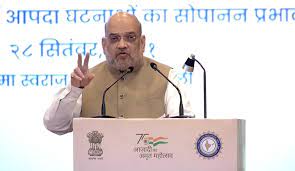30 Sep 2021 Aapada Mitra Programme

- Recently, the government has announced plans to have Disaster Management Volunteers (Aapda Mitras) in 350 districts of the country also released documents for Common Alerting Protocol (CAP)
- CAP is a simple but general format for exchanging all-hazard emergency alerts and public warnings over all kinds of networks.
About:
- It is a Central Sector Scheme that was launched in May 2016. NDMA (National Disaster Management Authority) is the implementing agency.
- It is a programme to identify suitable individuals in disaster-prone regions who can be trained to be first responders in times of disasters.
Aim:
- To provide the community volunteers with the skills that they would need to respond to their community’s immediate needs in the aftermath of a disaster thereby enabling them to undertake basic relief and rescue tasks during emergency situations such as floods, flash-floods and urban flooding.
Objectives:
- Training institutions to be empanelled by respective States/UTs at the State/UT level.
- To train community volunteers in life saving skills of disaster response (flood relief and rescue), coordination, assistance, and provide personal protective equipment and emergency responder kits;
- To create a Community Emergency Stockpile/Reserve at the district/block level containing essential light search and rescue equipment, medical first aid kits, etc.
- To disseminate training and education tools developed under the project to more flood prone districts in subsequent phases of the scheme.
Other Disaster Related Initiatives
Indian:
- National Disaster Response Fund.
- Disaster Management Act, 2005.
- Coalition for Disaster Resilient Infrastructure (CDRI)
Global:
- Sendai Framework for Disaster Risk Reduction 2015-2030.
- United Nations Office for Disaster Risk Reduction (UNDRR).
National Disaster Management Authority
- NDMA is the apex statutory body for disaster management in India. It is headed by the Prime Minister of India.
- It was formally constituted on 27thSeptember 2006, in accordance with the Disaster Management Act 2005.
- Its primary purpose is to coordinate response to natural or man-made disasters and for capacity-building in disaster resiliency and crisis response.
- It envisages to build a safer and disaster resilient India by a holistic, proactive, technology driven and sustainable development strategy that involves all stakeholders and fosters a culture of prevention, preparedness and mitigation.


No Comments